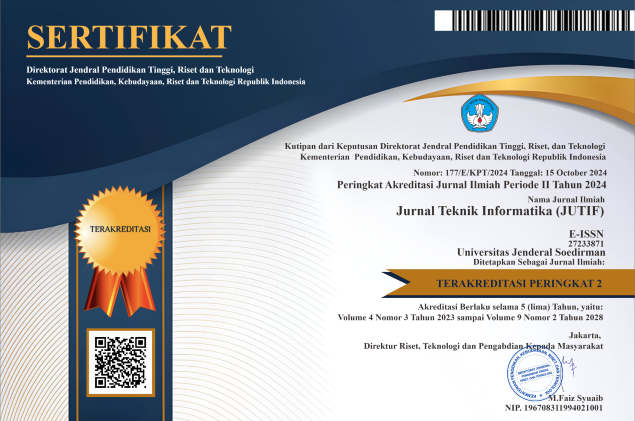Development of a Distributed Gradient Boosting Forest Algorithm with Residual Connections in Data Classification
DOI:
https://doi.org/10.52436/1.jutif.2025.6.4.4899Keywords:
Distributed Gradient Boosting Forest, Ensemble Learning, Gradient Magnitude, Residual Connections, Vanishing GradientAbstract
The growing complexity and volume of data across various domains necessitate machine learning models that are scalable and robust for large-scale classification tasks. Ensemble methods such as Gradient Boosting Decision Trees (GBDT) demonstrate effectiveness; however, they encounter issues concerning scalability and training stability when applied to very deep architectures. This work presents a novel enhancement using residual connections derived from deep neural networks into the Distributed Gradient Boosting Forest (DGBF) algorithm. By enabling direct gradient propagation across layers, residual connections solve the vanishing gradient problem and so improve gradient flow, accelerate convergence, and stabilise the training process. The Residual DGBF model was assessed using seven distinct datasets across the domains of cybersecurity, financial fraud, phishing, and malware detection. The Residual DGBF consistently surpassed the baseline DGBF in terms of accuracy, precision, recall, and F1-score across all datasets. Particularly in datasets marked by imbalanced classes and complex feature interactions, this suggests improved generalisation and higher predictive accuracy. By proving more stable and strong gradients across the depth of the model, layer-wise gradient magnitude analysis supports these improvements and so confirms the effectiveness of residual connections in deep ensemble learning. This work improves ensemble techniques by combining the scalability and interpretability of decision tree ensembles with the residual architecture optimising benefits. The proposed Residual DGBF enables future research on enhanced deep boosting frameworks by offering a strong and scalable method to address challenging real-world classification tasks.
Downloads
References
M. A. Ganaie, M. Hu, A. K. Malik, M. Tanveer, and P. N. Suganthan, “Ensemble deep learning: A review,” Eng Appl Artif Intell, vol. 115, p. 105151, Oct. 2022, doi: 10.1016/J.ENGAPPAI.2022.105151.
A. Mohammed and R. Kora, “A comprehensive review on ensemble deep learning: Opportunities and challenges,” Journal of King Saud University - Computer and Information Sciences, vol. 35, no. 2, pp. 757–774, Feb. 2023, doi: 10.1016/j.jksuci.2023.01.014.
M. A. Hossain and M. S. Islam, “A novel hybrid feature selection and ensemble-based machine learning approach for botnet detection,” Sci Rep, vol. 13, no. 1, Dec. 2023, doi: 10.1038/s41598-023-48230-1.
V. Borisov, T. Leemann, K. Sebler, J. Haug, M. Pawelczyk, and G. Kasneci, “Deep Neural Networks and Tabular Data: A Survey,” IEEE Trans Neural Netw Learn Syst, vol. 35, no. 6, pp. 7499–7519, Jun. 2024, doi: 10.1109/TNNLS.2022.3229161.
J. G. Sherwin Akshay, T. Vinusha, R. Sharon Bianca, C. K. Sarath Krishna, and G. Radhika, “Enhancing Credit Card Fraud Detection: A Comparative Analysis of Anomaly Detection Models,” 2024 IEEE International Conference on Computer Vision and Machine Intelligence, CVMI 2024, 2024, doi: 10.1109/CVMI61877.2024.10781986.
J. G. Sherwin Akshay, T. Vinusha, R. Sharon Bianca, C. K. Sarath Krishna, and G. Radhika, “Enhancing Credit Card Fraud Detection with Deep Learning and Graph Neural Networks,” 2024 15th International Conference on Computing Communication and Networking Technologies, ICCCNT 2024, 2024, doi: 10.1109/ICCCNT61001.2024.10725042.
Z. ; Yang et al., “Leveraging Mixture of Experts and Deep Learning-Based Data Rebalancing to Improve Credit Fraud Detection,” Big Data and Cognitive Computing 2024, Vol. 8, Page 151, vol. 8, no. 11, p. 151, Nov. 2024, doi: 10.3390/BDCC8110151.
Z. Zhang and C. Jung, “GBDT-MO: Gradient-Boosted Decision Trees for Multiple Outputs,” IEEE Trans Neural Netw Learn Syst, vol. 32, no. 7, pp. 3156–3167, Jul. 2021, doi: 10.1109/TNNLS.2020.3009776.
Y. Shi, G. Ke, Z. Chen, S. Zheng, and T.-Y. Liu, “Quantized Training of Gradient Boosting Decision Trees,” in Advances in Neural Information Processing Systems, Dec. 2022, pp. 18822–18833. Accessed: May 17, 2025. [Online]. Available: https://github.com/Microsoft/LightGBM
J. S. Yang, C. Y. Zhao, H. T. Yu, and H. Y. Chen, “Use GBDT to Predict the Stock Market,” Procedia Comput Sci, vol. 174, pp. 161–171, Jan. 2020, doi: 10.1016/J.PROCS.2020.06.071.
J. Chen, J. Zhong, and Z. Chen, “Research On the Pricing Model of Second-Hand Sailboats Based on GDBT Model,” BCP Business & Management MEEA, vol. 2023, p. 24, 2023.
Q. Lv, “Hyperparameter tuning of GDBT models for prediction of heart disease,” https://doi.org/10.1117/12.2668449, vol. 12602, pp. 686–691, Apr. 2023, doi: 10.1117/12.2668449.
J. Xu et al., “Predicting cerebral edema in patients with spontaneous intracerebral hemorrhage using machine learning,” Front Neurol, vol. 15, Oct. 2024, doi: 10.3389/fneur.2024.1419608.
L. E. Lwakatare, A. Raj, I. Crnkovic, J. Bosch, and H. H. Olsson, “Large-scale machine learning systems in real-world industrial settings: A review of challenges and solutions,” Inf Softw Technol, vol. 127, p. 106368, Nov. 2020, doi: 10.1016/J.INFSOF.2020.106368.
H. Seto et al., “Gradient boosting decision tree becomes more reliable than logistic regression in predicting probability for diabetes with big data,” Sci Rep, vol. 12, no. 1, Dec. 2022, doi: 10.1038/s41598-022-20149-z.
Q. Li, Z. Wen, and B. He, “Practical Federated Gradient Boosting Decision Trees,” Proceedings of the AAAI Conference on Artificial Intelligence, vol. 34, no. 04, pp. 4642–4649, Apr. 2020, doi: 10.1609/AAAI.V34I04.5895.
S. and K. N. A. and F. S. A. and R. K. Akram Faiz and Aziz, “Integrating Artificial Bee Colony Algorithms for Deep Learning Model Optimization: A Comprehensive Review,” in Solving with Bees: Transformative Applications of Artificial Bee Colony Algorithm, K. Raza, Ed., Singapore: Springer Nature Singapore, 2024, pp. 73–102. doi: 10.1007/978-981-97-7344-2_5.
Á. Delgado-Panadero, J. A. Benítez-Andrades, and M. T. García-Ordás, “A generalized decision tree ensemble based on the NeuralNetworks architecture: Distributed Gradient Boosting Forest (DGBF),” Applied Intelligence, vol. 53, no. 19, pp. 22991–23003, Jul. 2023, doi: 10.1007/s10489-023-04735-w.
T. Turino, R. E. Saputro, and G. Karyono, “Comparative Analysis of Decision Tree, Random Forest, Svm, and Neural Network Models for Predicting Earthquake Magnitude,” Jurnal Teknik Informatika (Jutif), vol. 6, no. 2, pp. 755–774, Apr. 2025, doi: 10.52436/1.JUTIF.2025.6.2.2378.
N. A. Syam, N. Arifin, W. Firgiawan, and M. F. Rasyid, “Comparison of SVM and Gradient Boosting with PCA for Website Phising Detection,” Jurnal Teknik Informatika (Jutif), vol. 6, no. 2, pp. 691–708, Apr. 2025, doi: 10.52436/1.JUTIF.2025.6.2.4344.
M. Tanveer et al., “Ensemble deep learning in speech signal tasks: A review,” Neurocomputing, vol. 550, p. 126436, Sep. 2023, doi: 10.1016/J.NEUCOM.2023.126436.
M. Shafiq and Z. Gu, “Deep Residual Learning for Image Recognition: A Survey,” Sep. 01, 2022, MDPI. doi: 10.3390/app12188972.
A. Khan, A. Sohail, U. Zahoora, and A. S. Qureshi, “A survey of the recent architectures of deep convolutional neural networks,” Artif Intell Rev, vol. 53, no. 8, pp. 5455–5516, Dec. 2020, doi: 10.1007/s10462-020-09825-6.
F. He, T. Liu, and D. Tao, “Why ResNet Works? Residuals Generalize,” IEEE Trans Neural Netw Learn Syst, vol. 31, no. 12, pp. 5349–5362, Dec. 2020, doi: 10.1109/TNNLS.2020.2966319.
Y. Hu, L. Deng, Y. Wu, M. Yao, and G. Li, “Advancing Spiking Neural Networks Toward Deep Residual Learning,” IEEE Trans Neural Netw Learn Syst, 2024, doi: 10.1109/TNNLS.2024.3355393.
W. Xu, Y. L. Fu, and D. Zhu, “ResNet and its application to medical image processing: Research progress and challenges,” Comput Methods Programs Biomed, vol. 240, p. 107660, Oct. 2023, doi: 10.1016/J.CMPB.2023.107660.
W. Wu, L. Huo, G. Yang, X. Liu, and H. Li, “Research into the Application of ResNet in Soil: A Review,” Agriculture 2025, Vol. 15, Page 661, vol. 15, no. 6, p. 661, Mar. 2025, doi: 10.3390/AGRICULTURE15060661.
A. Vaswani et al., “Attention Is All You Need,” in Proceedings of the 31st International Conference on Neural Information Processing Systems, Red Hook, NY, USA: Curran Associates Inc., Dec. 2017, pp. 6000–6010. doi: 10.5555/3295222.3295349.
S. Xie et al., “ResiDual: Transformer with Dual Residual Connections,” Apr. 2023, [Online]. Available: http://arxiv.org/abs/2304.14802
H. Wang, S. Ma, L. Dong, S. Huang, D. Zhang, and F. Wei, “DeepNet: Scaling Transformers to 1,000 Layers,” IEEE Trans Pattern Anal Mach Intell, 2024, doi: 10.1109/TPAMI.2024.3386927.
G. Daruhadi and P. Sopiati, “Pengumpulan Data Penelitian,” J-CEKI : Jurnal Cendekia Ilmiah, vol. 3, no. 5, pp. 5423–5443, Aug. 2024, doi: 10.56799/JCEKI.V3I5.5181.
D. Revaldo, “Android Malware Detection Dataset.” Accessed: May 19, 2025. [Online]. Available: https://www.kaggle.com/datasets/dannyrevaldo/android-malware-detection-dataset
J. Arvidsson, “Credit Card Fraud.” Accessed: May 18, 2025. [Online]. Available: https://www.kaggle.com/datasets/joebeachcapital/credit-card-fraud
S. Tiwari, “Web page Phishing Detection Dataset.” Accessed: May 18, 2025. [Online]. Available: https://www.kaggle.com/datasets/shashwatwork/web-page-phishing-detection-dataset
A. Oliveira, “Malware Analysis Datasets: API Call Sequences.” Accessed: May 18, 2025. [Online]. Available: https://www.kaggle.com/datasets/ang3loliveira/malware-analysis-datasets-api-call-sequences
Cyber Cop, “Phishing Email Detection.” Accessed: May 18, 2025. [Online]. Available: https://www.kaggle.com/datasets/subhajournal/phishingemails
N. Elgiriyewithana, “Credit Card Fraud Detection Dataset 2023.” Accessed: May 18, 2025. [Online]. Available: https://www.kaggle.com/datasets/nelgiriyewithana/credit-card-fraud-detection-dataset-2023
J. Arvidsson, “Android Malware Detection.” Accessed: May 18, 2025. [Online]. Available: https://www.kaggle.com/datasets/joebeachcapital/tuandromd
K. Maharana, S. Mondal, and B. Nemade, “A review: Data pre-processing and data augmentation techniques,” Global Transitions Proceedings, vol. 3, no. 1, pp. 91–99, Jun. 2022, doi: 10.1016/J.GLTP.2022.04.020.
A. Mutholib, N. A. Rahim, T. S. Gunawan, and M. Kartiwi, “Trade-Space Exploration with Data Preprocessing and Machine Learning for Satellite Anomalies Reliability Classification,” IEEE Access, 2025, doi: 10.1109/ACCESS.2025.3543813.
S. Amini, M. Saber, H. Rabiei-Dastjerdi, and S. Homayouni, “Urban Land Use and Land Cover Change Analysis Using Random Forest Classification of Landsat Time Series,” Remote Sensing 2022, Vol. 14, Page 2654, vol. 14, no. 11, p. 2654, Jun. 2022, doi: 10.3390/RS14112654.
M. Liu, L. Chen, X. Du, L. Jin, and M. Shang, “Activated Gradients for Deep Neural Networks,” IEEE Trans Neural Netw Learn Syst, vol. 34, no. 4, pp. 2156–2168, Apr. 2023, doi: 10.1109/TNNLS.2021.3106044.
I. Dubinin and F. Effenberger, “Fading memory as inductive bias in residual recurrent networks,” Neural Networks, vol. 173, p. 106179, May 2024, doi: 10.1016/J.NEUNET.2024.106179.
Additional Files
Published
How to Cite
Issue
Section
License
Copyright (c) 2025 Rayhan Dhafir Respati, Sopian Soim, Mohammad Fadhli

This work is licensed under a Creative Commons Attribution 4.0 International License.



























